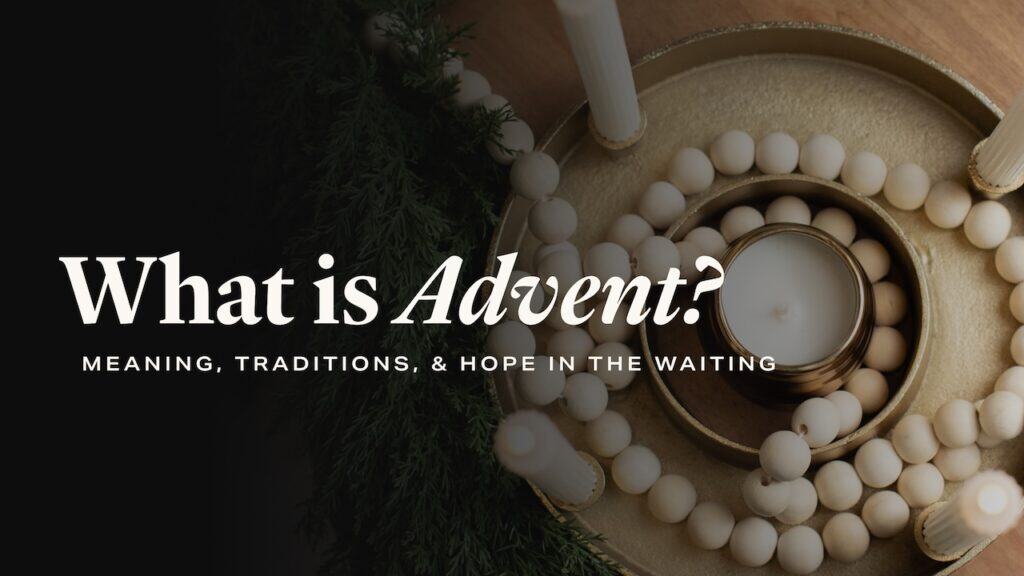Waiting with Hope
Each year, as lights go up and calendars fill, we find ourselves caught between the hustle of Christmas and the holy quiet of something more profound. Long before Advent wreaths and countdown calendars, the Church marked these weeks not with busyness, but with longing, and with the quiet ache of waiting for what God had promised.
Advent is more than tradition. It’s a practice of hope, shaped by a story that began long before Bethlehem. It invites us to pause, to remember that light always breaks through the dark, and to prepare room in our hearts for the One who came once and will return again.
What Is Advent?
The word Advent comes from the Latin adventus, meaning “coming” or “arrival.” It’s a four-week season observed by Christians around the world as a time of anticipation, reflection, and preparation.
When we ask, what is Advent?, we’re really asking how we can live in the tension of the “already” and the “not yet,” between Christ’s first coming in Bethlehem and His promised return. The Advent season begins four Sundays before Christmas and serves as the opening of the liturgical year in many Christian traditions. While Christmas celebrates the birth of Christ, Advent helps us prepare for it. It is a season of expectation rather than arrival, a sacred pause to remember why His coming matters.
The Origins of Advent
The earliest records of Advent go back to the 4th and 5th centuries, when the Church used this season as a time of fasting, prayer, and repentance, making it similar to Lent. It was less about festivities and more about formation.
As centuries passed, Advent became a season of joyful preparation rather than strict fasting, but its purpose remained the same: to make people ready for the coming of Christ. By the Middle Ages, church communities began marking the season with candles and readings, shaping the traditions that continue today. Advent reminds us that preparing for Christmas isn’t primarily about decorating our homes; it’s about preparing our hearts.
The Two Comings of Christ
At its heart, the meaning of Advent is twofold. We look back to Christ’s first Advent, His humble birth in Bethlehem, and we look forward to His second Advent, His glorious return. The first Advent tells the story of God entering human history, taking on flesh, and dwelling among us. The second Advent reminds us that this same Jesus will come again to make all things new.
Advent is about learning to live between those two arrivals with faith, patience, and hope. It’s the same hopeful waiting described in Isaiah 40:31: “But those who wait on the Lord will renew their strength…” That word “wait” in Hebrew, qavah, means to wait with tension, with expectation, with hope. It’s where QAVA gets its name: waiting on God not passively, but with active trust. We look back with gratitude and forward with hope.
Advent Symbols and Traditions
Though expressions of Advent vary by culture and denomination, most practices center around light, symbolizing Jesus as the Light of the world who pierces the darkness.
The Meaning of the Advent Candles
At the heart of this celebration in many homes and churches is the Advent wreath, made of evergreen branches and candles formed in a circle to represent eternal life. Each candle carries a meaning that helps tell the story of Christ’s coming:
- Week 1: Hope (Prophet’s Candle): Remembering the hope foretold by the prophets.
- Week 2: Peace (Bethlehem Candle): Reflecting on the peace Christ brings to the world.
- Week 3: Joy (Shepherd’s Candle): Marked by a pink candle, symbolizing joy breaking through despair.
- Week 4: Love (Angel’s Candle): Celebrating God’s great love revealed through His Son.
- Christmas Eve or Day: Christ Candle: The white candle in the center represents Jesus, the Light who has come.
Each week, as another candle is lit, the flame grows brighter, mirroring how Christ’s light grows stronger in the darkness. Many families also read Scripture or follow an Advent devotional to center their hearts on the story of redemption. Colors also play a part in Advent traditions: purple for royalty and repentance, pink for joy, and white for purity. Each detail reminds us that the story of Jesus isn’t just history, it’s hope, still unfolding in us.
How to Celebrate Advent Today
You don’t have to be part of a liturgical church to celebrate Advent meaningfully. Advent can be practiced in simple ways that reorient your heart toward Christ amid a noisy season.
Here are a few ways to observe the Advent season:
- Light candles weekly and read related Scriptures (Isaiah 9, Luke 1–2, John 1).
- Pray as a family for hope, peace, joy, and love to grow in your home and community.
- Practice generosity, serve someone in need, or give sacrificially as an act of worship.
- Slow down, turn off the noise, reflect, and rest in God’s presence.
This Advent, QAVA is offering a free 25-day video devotional designed to help you slow down and rediscover the wonder of Christ’s coming. Each day’s reflection invites you to see Advent not just as a countdown to Christmas, but as a season of hopeful expectation.
In addition, if you want something extra special to watch with your family each Sunday evening as you pause and light that week’s candle, check out our Advent series on the app called “Echoes of Emmanuel.”
Advent FAQs
When does Advent start?
Advent begins four Sundays before Christmas and lasts until Christmas Eve. In 2025, Advent begins on Sunday, November 30.
Is Advent in the Bible?
While the word “Advent” isn’t used in Scripture, the themes of waiting and preparation are woven throughout, from the prophets’ longing for the Messiah to Jesus’ call to stay watchful for His return.
What do the Advent candles mean?
The candles represent hope, peace, joy, love, and Christ, the growing light of His coming into a dark world.
How is Advent different from Christmas?
Advent is a time of preparation and anticipation; Christmas is the celebration of Christ’s birth. Advent helps us get ready for the joy that Christmas declares.
Can I celebrate Advent if my church doesn’t?
Absolutely. Advent is a spiritual practice, not just a church program. You can mark the season at home through Scripture readings, prayer, and reflection.
Hope in the Waiting
Advent reminds us that God’s promises are worth the wait. We live in the tension between what has been fulfilled and what is still to come. In a world that rushes toward instant gratification, Advent slows us down. It teaches us to watch for God’s presence, to listen for His voice, and to trust that His timing is always perfect.
As we light each candle and lift our hearts in expectation, may this prayer anchor us once again:
Come, Lord Jesus.
Light the darkness of our world.
Fill our waiting with hope.
And teach us to live ready for Your coming.
Advent is more than a season; it’s an invitation to hope.







